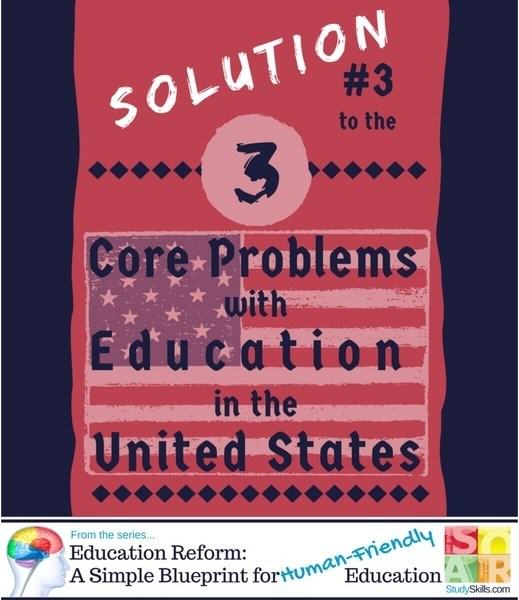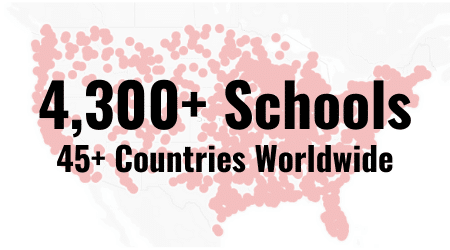Solutions for Core Problem #3 with Education in the United States
This article is from our series, Education Reform: A Simple Blueprint for Human-Friendly Education. For a directory of all articles in this series, click here. To get the full series in one downloadable PDF, sign-up for the free report in the black box on the right.

In a previous article, I described Three Core Problems with US Education:
Core Problem #1: There is a serious motivation crisis among our students.
Core Problem #2: There is a lack of relevance in our curriculum.
Core Problem #3: We are using completely irrational and ineffective models for learning.
Within each problem, there are simple leverage points that can initiate great change without radical “restructuring” of the existing system… (The radical restructuring can come later.)
Solution for Core Problem #3:
The Use of Completely Irrational and Ineffective Models for Learning
If we address Core Problems #1 & #2, much of #3 is already accomplished. However, the Success Pyramid is a model that tells us how to make learning more human-friendly.
Continue Building Confidence.
This strategy correlates with Level 1 of the Success Pyramid (Confidence) and Region 1 of the brain (the Emotional Center).
As mentioned in the previous section, change the conversation with students to “HOW are you smart?” Lead with their strengths! This is the greatest leverage point for building confidence.
Another very useful strategy is to transition students into the “Green Zone,” where emotions are, at the very least, neutral. The brain is incredibly sensitive to a wide range of conditions, but the good news is that the brain can be easily swayed into the Green Zone… if you are aware of the need for this “maneuvering.”
How to Transition Students to the Green Zone
- Start with strengths! Change the conversation to “HOW are you smart?”
- Teach students about the Theory of Multiple Intelligences; promote self-investigations into the various intelligences.
- Open class with a funny story, puzzle, video, light-hearted anecdote. This helps to “wipe the slate clean.”
- Allow movement. Movement generates new brain chemicals. Especially aerobic movement. (Jumping jacks are a great, classroom-friendly, aerobic exercise!)
- Encourage “pairing.” We humans are social creatures! Allowing students to learn through socializing is very Green Zone-friendly. (Learn how “pairing” has transformed our company, here.) Just be sure to avoid triggering anxiety with this one… for example, assign partners so no one feels left out.
See a previous article/video about The Green Zone, here. (This is our most popular article!)
Provide Choices!
Finally, the ability to make choices is very powerful to inspire motivation. Countless studies consistently confirm that having “choices” promotes higher levels of performance and feelings of well-being than situations providing no choice, especially in the classroom.1
When a student has the authority to make a choice for themselves, they internalize that opportunity to mean, “I matter. My opinion matters. My voice is heard.” When students do not feel this healthy sense of empowerment, they are much more vulnerable to poor influences, such as: substance abuse, other self-destructive behavior, bullying, violence, etc.
A good example of the power of simple choices is to consider the most popular ride at Walt Disney World. WDW is the “most magical place on Earth.” It is filled with advanced technology that brings amazing adventures and fantasies to life! But the most popular attraction is nothing more than a simple carnival ride… Dumbo! In fact, Dumbo is so popular, WDW added at least two more rides exactly like it to other parts of the park: Aladdin’s Carpet Ride and Astro Orbiter.
Why is “Dumbo” so popular?
Because of the joystick; children love to make the ride go up and down! And for those 30 seconds of “control,” they will wait in line for hours.
Simple choices are very powerful!
How to Provide More Choices in the Classroom
The following is a short list of examples of classroom choices. Of course, there are countless options, limited only by your creativity, but this list can help you get started. You will notice they are all: 1) truly simple, and 2) provide options that are reasonable to manage in the classroom. Do not let their simplicity fool you; even “small” choices are very powerful!
- Do you want to use a paper or electronic planner?
- Do you want to read the chapter by yourself or with a partner?
- Do you want to read Chapter 4 on your own, or have small groups role-play each section of the timeline for the whole class?
- What color binder do you want: red, yellow, blue, or black?
- Do you want to do homework on the bus or socialize with your friends and do homework later?
- When will you “power down” at home: from 4:00-6:00 pm, 6:00-8:00 pm, or 4:00-5:00 and 7:00-8:00?
- Choose your own seat.
- Choose topic one, two, or three for your writing assignment.
- Will you take notes with a pen, pencil, colored pencil, or thin-line marker?
- Do you want to do 8 or 10 practice problems for your math test?
- Do you want to answer the Lesson Review questions on paper or out loud?
- Do you want to do your Exit Presentation as a report, make a slide presentation, or create a website?
- Do you want to work independently, or with a partner?
- Do you want the lights on or off?
- Do you want to have music on or off?
- Would you rather work on the floor or in your seat?
- Do you want to do your assignment by writing, reading it out loud, or acting it out?
Teach Brain-Friendly Organization Skills
This recommendation correlates with Level 2 of the Success Pyramid (Self-Management) and Region 2 of the brain (the Front Brain).
For the most part, explicit instruction of organizational skills is best to introduce in 4th grade (age 10), with scaffolded support through 7th-8th grade. (Although, it’s never “too late” to provide instruction in these skills.)
Students benefit most when their school presents a unified system for organizing papers and managing assignments. Such a system prevents confusing contradictions from different teachers. Additionally, students must receive explicit instruction in how these systems work.
NOTE OF CAUTION: It is extremely important that these “systems” focus on ultra-efficiency. Do not saddle students with a dozen or more different folders and notebooks. These are too many supplies for students to manage across multiple locations: home, bus, locker, 5-7 different classrooms a day, and back to the locker, bus, and home for the day. The more supplies required for a system, such as highlighters and/or color-coded papers, the more likely the system is to break down. The more actions required, such as the expectation to 3-hole punch papers, the more the system will break down.
The Front Brain has a limited power supply for managing organizational tasks; our brain biology dictates that efficiency is essential.
Facilitate Learning Through Connections
This recommendation correlates with Level 3 of the Success Pyramid (Learning) and Region 3 of the brain (the Back Brain).
Since the brain only learns by connecting new information to something it already knows, education must embrace the three ways to develop connections:
- Through previous knowledge and life-experience.
- Through hands-on experience.
- Through asking questions.
How to Learn Through Previous Knowledge and Life Experience
Educators have long been encouraged to “activate prior knowledge” of students. In fact, formal lesson plans begin with something called an “Anticipatory Set.” This is where the teacher is expected to describe how he plans to help students connect the information they’re about to learn with something they already understand. However, in reality, the “anticipatory set” is often overlooked in the classroom.
Students MUST see the connection between what they already know to what they are about to learn. If students do not understand how to connect new learning into their existing understanding of the world, all they will accomplish is “rote memorization.”
Therefore, we must make every effort to create learning conditions that promote CONNECTIONS to experiences students have had and/or facts, concepts, and ideas they already understand. Without “connection,” there is NO learning.
Some ways to “activate prior knowledge” include:
- Sharing stories.
- Sensory experiences.
- Guided imagery.
- Use of visuals (photos, models, charts, diagrams, and illustrations.)
- Use of video.
How to Learn Through Hands-On Experience
“Hands-on, experiential” learning is the most natural form of learning for human beings and therefore, is highly motivating. Just look at a toddler learning how to walk and exploring his world; everything is a bonanza of learning opportunities, but it all comes from touching, experimenting, trying, and “failing” (which is a really negative word for simply “getting feedback”), and trying again.
Maria Montessori believed the hands were an extension of the brain. Neuroscience has now confirmed that to be true. In fact, in the very first stage of human development, the zygote develops into three cells. One of those cells develops into the circulatory and skeletal system. Another cell develops into the immune system and organs. The third cell becomes the brain and skin. In other words, the brain and skin are so interconnected that they are formed at the same time, from the same, original cell.
How to Learn Through Asking Questions
Questions naturally activate connections to the Back Brain. The Back Brain is very powerful and deeply connected.
When we ask a question, our brain automatically prepares neuron wires, primed and ready to make connections to other regions of our brain. This is how we develop long-term understanding and recall.
The key is for students to know how to ask questions about new content. One of the most basic questions students can ask themselves during lectures or while reading a textbook is, “Why is this information here?” or “Why is my teacher sharing this information?” Ultimately, this question should prompt the student to connect the specific information to the main topic.
The most powerful leverage point for “asking questions” lies in textbooks. Specifically, in the visuals. Students should read their textbooks before class, paying close attention to the visuals.
Visuals are such a strong leverage point because:
- The brain can process visuals instantly (versus text, which requires several additional layers of decoding and interpretation).
- Visuals and their captions capture 30-80% of the information in the text. (The visuals in texts designed for grade 1 thru grade 6 typically communicate 60-80% of the main information. College-level texts communicate approximately 30% of the main topics through visuals.)
Students should “read the visuals.” This process includes three steps:
- Looking at the picture, image, or chart.
- Reading the caption.
- Asking themselves, “Why do I think this visual is here?”
The third step is the most important because it is the question that forges a connection. Students should attempt to answer this question by trying to determine a connection between the image and topic of the chapter (typically described in the chapter title).
Sometimes, their guess may be wrong. That’s okay.
The most important part of this process is simply that their brain made a connection. If they made a mistake, their brain will be sure to notice it later, when they read the black-and-white text or listen to a related lecture.
If their prediction was wrong, the Emotional Center of the brain gets involved and will work to correct the prediction quickly. Emotions create extra-strong connections in the brain, which is why mistakes are such a powerful learning tool.
“Reading the visuals” in a text prior to a lecture also improves listening comprehension. The visuals act as “listening anchors” during a lecture. Students can make better connections with lectures when they can “visualize” related visuals. This is especially true when the lecture strongly relates to the text because the visuals illustrate the main points of the text.
Conclusion
A recap of the solution described above:
Core Problem #1: There is a serious motivation crisis among our students. Change the conversation in classrooms and schools to HOW are you smart. To inspire confidence, learning must begin with a strengths-based approach.
Core Problem #2: There is a lack of relevance in our curriculum. Modify curriculum and instruction so that it is relevant to the content and skills needed in the real world. This strategy promotes engagement and allows students to make real-world connections that are biologically vital for effective learning.
Core Problem #3: We are using completely irrational and ineffective models for learning. The solutions to Core Problems # 1 & 2 automatically address 2/3rds of the equation for building more effective models for learning: Inspire motivation through a strengths-based approach to instruction. Make curriculum relevant. Teach students brain-friendly strategies to communicate and get organized. Finally, encourage them to make connections through: previous knowledge/experiences, hands-on experience, and asking questions.
In the next article, we’ll take a look at Special Education: It Doesn’t Have to Be So Difficult.
To our students’ success,
Susan Kruger, M.Ed.
Education Reform: A Simple Blueprint for Human-Friendly Education
This article is from our full report on education reform. Portions of the report will be released on a weekly basis in article form (see the directory below).
However, to access the full report (in its entirety) now, sign-up in the black box on the right.
Education Reform Article Directory:
- Introduction to Education Reform: A Simple Blueprint for Human-Friendly Education
- Three Core Problems with Education in the United States
- The Success Pyramid: A Model of Effective & Efficient Learning
- The Brain Biology of Learning: Why the Success Pyramid Works
- Solutions for Core Problem #1 with Education in the United States
Solutions for Core Problem #2 with Education in the United States
Solutions for Core Problem #3 with Education in the United States - Special Education: It Doesn't Have to Be So Difficult - Part I of III
Special Education: How to Solve & Prevent Learning Disabilities - Part II of III
Special Education: The Brain Biology of ADHD & Autism - Part III of III - Ideal Instructional Models: Successful Examples of Complete Human Education
- Finland: A Political Model of Education Reform
- Why Common Core Is the Worst & BEST Thing to Happen to Education
- The Simplest Leverage Points in Reading, Math, & Skills Instruction
- Looking Forward: Advice from a Futurist
- Conclusion: The Four Principles of Optimal Instruction
- Summary: An Ideal School System
SPECIAL REPORT: To get the full series in one downloadable PDF, sign-up for the free report in the black box on this page.

Sources
1 Lillard, Angeline Stoll. Montessori: The Science behind the Genius. New York: Oxford U, 2007. Print. Pages 82-113.
Six Steps to
Conquer the Chaos
Get Our Free Guide & Information on...

"*" indicates required fields
SOAR® in the News
The SOAR® Curriculum
The most critical learning, organizing, and communication skills needed for school. Learn more here.
Who’s Using SOAR®?
SOAR® Guarantee
Click here to learn more.





